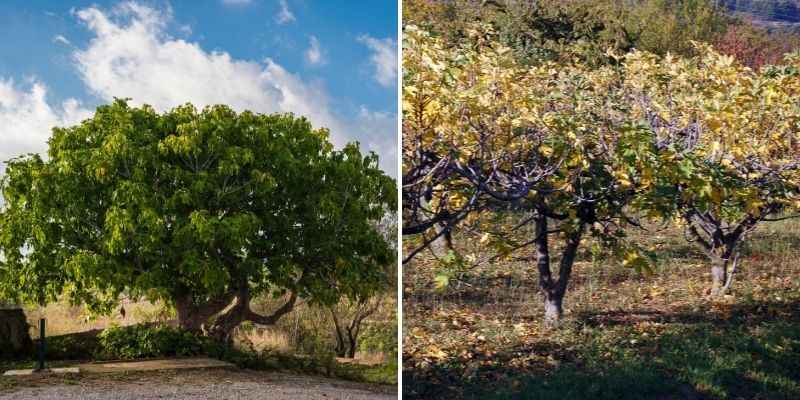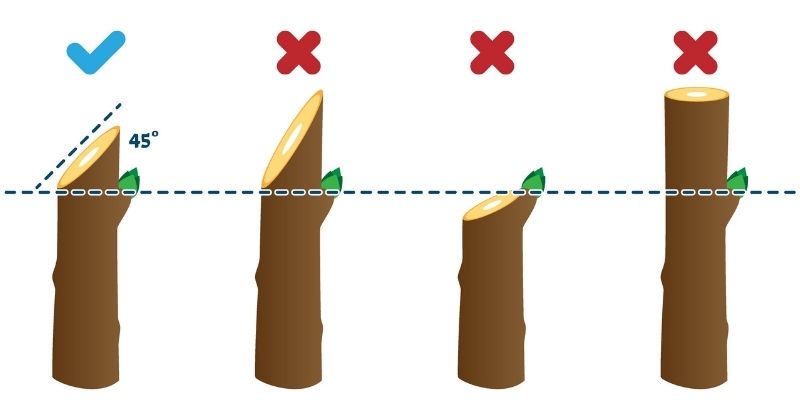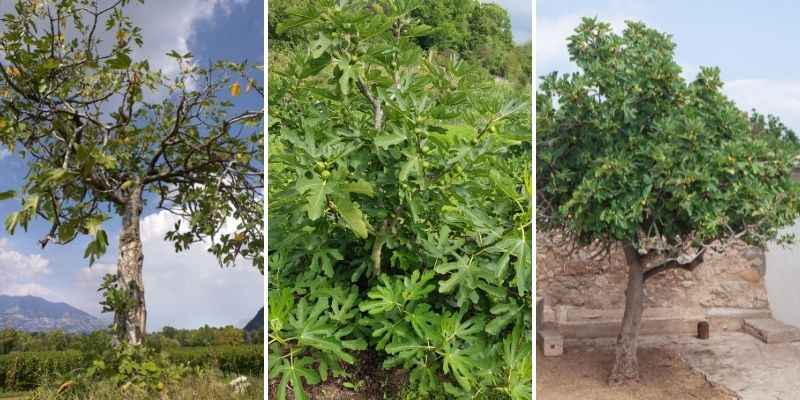Pruning fig trees is not always necessary, but helps control size, makes harvesting easier and improves yield. For a mature, vigorous fig tree, gentle annual pruning is often recommended, especially in cooler regions to encourage fruiting. So, when and how to prune a fig tree? Discover in this tutorial all our tips for a healthy tree, attractive shape and abundant harvest of figs.

Left, a large fig tree with fruit high up that are difficult to pick. Right, pruned fig trees so fruit can be picked at comfortable height.
When to prune a fig tree?
Pruning period for fig tree depends on region where tree is planted and on fig tree type. To know which months to prune a fig tree, generally recommend late winter or early spring, ideally between February and March, before bud break.
- In colder regions, winters are harsher; single-crop fig trees are preferred. Prune at end of winter (late February/March).
- In areas with a mild climate, biferous fig trees are more commonly grown. You can prune this type of fig tree at end of winter or possibly just after harvest, that is in autumn, between October and November.
How to prune a fig tree?
There are two types of fig trees:
- single-crop fig trees: they produce fruit only once a year, in late summer (August/September, sometimes October) on current-year wood;
- biferous fig trees: they fruit twice a year. In early summer (June/July) summer figs develop on previous-year wood. In autumn (late August to October) autumn figs are harvested; these have grown on current-year wood.
please note : single-crop and biferous fig trees are pruned differently.
→ Also see Olivier’s advice sheet: Biferous or single-crop fig tree: what are differences?
Tools needed for pruning
- Well disinfected and razor-sharp pruning tools: pruning shear, loppers and pruning saw for large branches
- Wound sealant
Good to know : fig tree sap is irritating, so wear a pair of gloves. Sap on skin combined with sun exposure can cause burns and blisters.
Good pruning practices
- Never prune in wet weather.
- Make angled cuts, above a bud facing outwards, so water will not sit on cut surface and disease risk is reduced.
- Always remove dead or diseased wood.
- Open up centre of tree by removing crossing branches or branches growing inwards so future fruit receive maximum light.
- Cut branches that are too low, growing toward ground, too thin, frost-damaged, as well as poorly formed shoots and oldest ones.

Make clean cuts above buds to limit disease risk: 45° angled cut, not too high, not too low
Pruning biferous fig trees
For biferous fig trees, in February/March, do not cut branches from previous year. These bear rounded buds that will become summer figs. These buds formed before winter and will develop in spring. If you remove these shoots, you will not get summer fruit. Leaf and wood buds, by contrast, are pointed. If in doubt, wait until buds are a little more developed to better distinguish both bud types.
- On shoots with buds for summer figs, remove all leaf buds that appear (suckering), except for first leaf bud pointing outwards which should be kept at base of each branch.
- After first harvest, in late July/August, cut above bud left in March that has grown into a shoot. These new shoots will produce second harvest in September/October. Prune their tips to prevent excessive elongation and to encourage good autumn fruiting.
- After autumn harvest, remove oldest branches from stump that need renewing.
Pruning single-crop fig trees in late winter
Because this fig tree fruits only once a year in autumn, cutting in late winter the following year has no consequence for next autumn’s crop. This pruning is simpler than for biferous fig trees. It is strongly recommended in cooler regions, every year in late winter, to concentrate sap where needed and give figs time to ripen. Here are our maintenance tips:
- Shorten long shoots by about one third, and shorten secondary shoots above third bud facing outwards (counting from base of shoot). Fig tree will produce new wood up to autumn where figs will appear.
- After pruning, fig tree will produce many suckers. To concentrate sap on fruiting, during growing season select suckers that will replace old branches and remove others. To avoid exhausting tree, around a dozen main branches suffice.
- After fig harvest, cut back current-year shoots that have fruited, if you choose not to prune fig tree next year in late winter.
How to prune a young fig tree?
Formative pruning gives attractive framework to tree. For this, during first three years, remove branches that cross over centre of tree. This allows light to penetrate heart of tree. Also cut branches that grow too far outwards. Main scaffold branches kept should form a neat crown (fig tree on trunk) or tuft (fig tree in coppice shoots). Pinch tips of shoots (leaf/wood buds) after winter to encourage branching.
How and why to rejuvenate an old fig tree?
Very old fig trees produce fewer fruits and become bare at base. To restore balanced silhouette and vigour, harder pruning is necessary and can be done every 20–25 years to avoid exhausting tree. Rejuvenation pruning consists of cutting branches on stump back to 50 cm above ground level.
For an old fig tree grown as coppice shoots (multiple trunks)
Prune first half of branches in first year, then remainder the following year. Branches left in first year will act as sap-pullers. New shoots will develop on cut branches. Keep only half of these and tip them for better fruiting.
For an old single-trunk fig tree
Shorten all branches to 50 cm from trunk tip. Shoots will appear. In summer, remove half of them and cut back remaining half by one third. Repeat operation next year, then switch to maintenance pruning in following years.
If you want to reduce an overly tall fig tree
You can convert an old single-trunk fig tree into a coppiced form. Cut fig tree back to ground level. In spring, keep only most vigorous shoots and shorten them slightly to encourage better branching.
Tip: to remove large or long branches and avoid tearing bark, cut them in two stages.

Old fig tree, coppiced fig tree with bushy habit and single-trunk fig tree
Care after pruning
Fig tree is vulnerable to disease after pruning, so we recommend protecting pruning wounds with a healing product (ready-to-use wound sealant for fruit trees). Diseases such as fig canker can enter through these wounds. If tree is weakened, it may then be attacked by other diseases or parasites.
Apply sealant immediately after pruning, covering edges of cut thoroughly. This wound dressing also offers protection if late frosts occur in April.
Mistakes to avoid
- Pruning too late in season: this can reduce fruit production for following year.
- Pruning too severely: excessive pruning can stimulate leaf growth at expense of fruit.
- Not pruning at all: lack of pruning can lead to an overly dense tree with poor air and light circulation.
- Ignoring fig tree type: some fig trees produce on previous-year wood (summer figs), while others fruit on current-year wood (autumn figs).
- Not disinfecting pruning tools: this can spread disease from branch to branch or tree to tree. Always use clean, sharp tools.
- Pruning young trees too early: let young fig trees establish before undertaking significant pruning.
- Forgetting to remove dead, diseased or crossing branches
































Comments